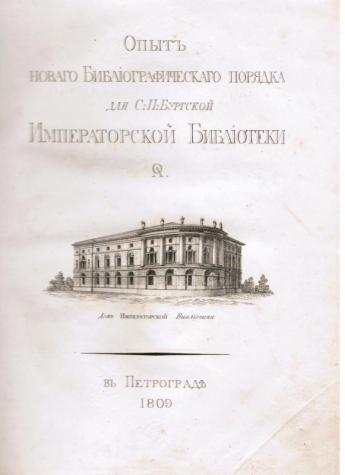Antiquarian Booksellers' Association Simon Beattie Ltd
Organising a Library

By Simon Beattie
This is the first edition of the first comprehensive library classification system to be published in Russia, and the first Russian guide to bibliographic description and catalogue production, an important text from the early years of the Imperial Public Library (now the National Library of Russia) in St Petersburg.
‘The pre-eminence among the world’s libraries of the Imperial Public Library in St Petersburg, achieved shortly after its founding early in the nineteenth century, was due largely to the remarkable skills and vision of the library’s first director, Aleksei Nikolaevich Olenin (1763–1843) … Founded in 1795 by Catherine the Great, already by 1820 it was second in size among European libraries to the Bibliothèque nationale; even though at that time it was a much younger institution than either the British Museum (founded 1753) or the Preussische Staatsbibliothek (founded 1661), it had already surpassed them in number of volumes held.
‘Compared to most other state institutions in Russia in the nineteenth century, the Imperial Public Library enjoyed a relatively high degree of autonomy … Particularly in the formative years, the library’s identity was shaped almost singlehandedly by its directors, and over the course of each director’s tenure its development was a function of that individual’s energy, initiative, and vision. At no time was this phenomenon more evident than during the administration of the library’s first director, Aleksei Nikolaevich Olenin … Essentially starting from scratch in every aspect of the library’s organization, Olenin’s accomplishments in the library were remarkable …
‘Olenin’s first undertaking as the director of the library was to assess the condition of the collection. He ordered an inventory of the holdings, which was complete in 1809. The results [appended at the end of his published Essai, p. 99–100] … showed a total of 238,632 volumes (including 45,000 duplicates …), 12,000 manuscripts, and 24,574 prints. There were only eight books in Russian or Old Church Slavic at this time.
‘In his first report as director of the library … Olenin described the two main problems he faced in the first year of his administration. First, there were major deficiencies in the physical facilities [double-, triple-, even quadruple-shelving, poor lighting, high humidity]. Second, the library did not have a uniform system for the organization of the collection. Olenin felt that these problems had to be corrected before the library could be opened to the public, and he immediately set about designing solutions …
‘To remedy the second problem Olenin designed his own classification system for the library. This “New Bibliographical System” was implemented in October 1808, scarcely six months after his appointment, and was published the following year under the title An Attempt at a New Bibliographical System for the St Petersburg Imperial Library. Although two classification schemes had been published in Russia prior to Olenin’s, both were created to organize a relatively small and fixed number of entries in a published work … These earlier attempts should not obscure the fact the Olenin’s Attempt was the first comprehensive library classification system published in Russia. It was also the first Russian guide to bibliographic description and catalog production …
‘In the introduction to the Attempt Olenin reviewed the major classification systems in use in European libraries and briefly characterized the shortcomings of each system … In Olenin’s view, the natural separation between the sciences and the arts was fundamental to the classification of knowledge. Moreover, a coherent classification system would show the logical transitions from one branch of knowledge to another. These two criteria constitute the theoretical foundation of Olenin’s system and also its chief contribution to classification theory …
‘In addition to the classification system, Olenin’s Attempt contains instructions for the compilation of three catalogs for the library … Olenin also formulates rules for the bibliographic description of books and manuscripts in the catalogs. Each record was to contain the full title of the work, the full name of the author and publisher or printer, the place and date of publication, the number of volumes, and the size’ (Mary Stuart, Aristocrat–Librarian in Service to the Tsar: Aleksei Aleksei Nikolaevich Olenin and the Imperial Public Library, Columbia University Press, 1986, pp. 1, 5, 62–5).
The book is printed in French and Russian on facing pages. The two title-pages, produced by the engraver Kolpakov, depict the library buildings in Warsaw (the Załuski collection, from which over 200,000 volumes were transferred to Russia in 1795) and St Petersburg.
***
(Posted on Simon Beattie's blog "The Books You Never Knew You Wanted", presented here by permission of the author. Pictures: Simon Beattie)


